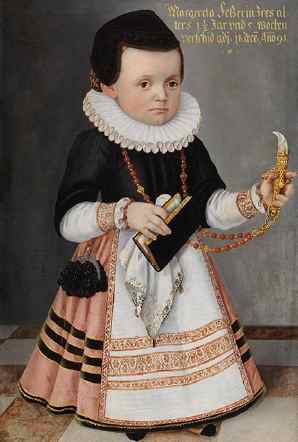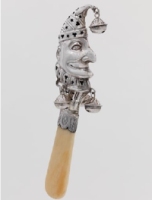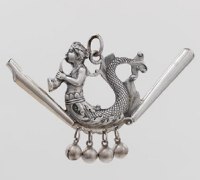by the
Staff of Zilvermuseum Sterckshof Provincie Antwerpen
(click on photos to enlarge image)
CORALS AND BELLS - A COLLECTION OF RATTLES
An Exhibition at the Zilvermuseum Sterckshof Provincie
Antwerpen
October 6, 2009/January 10, 2010
 |
Rattles are among the oldest toys in the world. They
appear in pre-Columbian America, in Pharaoh's Egypt and
even in the Hittite kingdom. It is thought that during
the earliest civilizations rattles consisted of a dried
fruit whose seeds sounded like little bells when shaken.
So it is hardly surprising that the oldest known
examples, which are made of earthenware and bronze, are
in the shape of a gourd or pomegranate.
Though a rattle was first and foremost a small toy used
to distract the young child and calm it when teething,
it was always believed that the object had exorcising
and protective powers as well. It was thought to avert
calamity and to help dispel evil.
A rattle was considered the ideal object to protect the
child from illness and adversity; it was seen as a
guarantee of a long and happy life. At a time when the
infant mortality rate was very high because there was no
known cure for a whole host of illnesses, the rattle
served as an amulet. Great importance was attached to it
and hope drawn from it.
Materials like coral, rock-crystal and wolf's tooth were
used for rattles not only because of their beauty, but
also because of the special, supernatural powers
attributed to these costly materials. Wolf‘s tooth, for
example, symbolized power. It was supposed to transfer
power from the animal to the child and in that way
protect it against danger. Coral was widely known as a
defense against evil, while rock-crystal was reputed to
soothe wounds. In other words, a rattle was once much
more than just a toy.
|
Besides the historical collection of rattles, the
exhibition "Corals and Bells - A Collection of Rattles"
also shows a series of portraits of children
depicted with their rattle. The rattles in these
paintings are made of silver or gold and have a handle
made of red coral, rock-crystal or wolf's tooth. These
sorts of rattles began to appear in children's portraits
at the beginning of the sixteenth century. Later on the
basic design was elaborated on by adding a whistle or
little bells. These accessories were also believed to
dispel evil spirits.
The use of costly materials largely determines a
rattle's price tag and can make it very valuable. But
not everyone favoured such sophisticated toys. For
example in his book Emile ou de l'éducation (1762), the
eighteenth-century French philosopher Jean-Jacques
Rousseau criticized these luxury rattles because they
accustomed children to opulence at a very young age.
Rousseau believed that a twig, a stick of liquorice or a
poppy head is equally effective when it comes to
distracting or entertaining a child.
|
 |

|
Not until the nineteenth century was the rattle
popularized. Inexpensive pewter versions appeared for
the first time. Many were in the shape of a mini-drum
filled with dried grain which produced a jingling sound
when shaken. In the same period rattles were also
produced depicting an important person or commemorating
a significant event. In the twentieth century plastic
became the material of choice and rattles were
mass-produced.
One of the most striking aspects of the Corals and Bells
exhibition is the sheer variety of jingling toys, both
in terms of their shape and decoration. The private
collection comprises 167 rattles which cover the period
from the beginning of the eighteenth century through to
the middle of the last century. They were made in
Belgium, England, France, the Netherlands and Spain. The
objects are shown alongside captivating miniature
portraits and portraits of children depicting the tiny
owner holding his or her rattle.
|
Zilvermuseum Sterckshof
Provincie Antwerpen
Hooftvunderlei 160
b-2100 Antwerp-Deurne
t +32 (0)3 360 52 52
info@zilvermuseum.be
www.zilvermuseum.be
|
Visiting the Corals and Bells exhibition you will
see the child, its toy and reproductions of both in
their historical context.
To tie in with the exhibition, Sterckshof Silver Museum
is producing a catalogue containing illustrations of the
artworks and objects on show. The publication is Number
39 in the Sterckshof Studies series and includes
articles by Marc Jacobs, Director of FARO (Flemish
Centre for Cultural Heritage), and by Annemarieke
Willemsen, Curator Middle Ages Collection at the Dutch
National Museum of Antiquities (Rijksmuseum van Oudheden)
in Leiden.
The exhibition is realized in association with Emil
Fonfoneata.
|
ASCAS is in debt
for their kindness to Zilvermuseum Sterckshof
Provincie Antwerpen and to Emil Fonfoneata
|
|
|
 ASSOCIATION OF SMALL COLLECTORS OF ANTIQUE SILVER
ASSOCIATION OF SMALL COLLECTORS OF ANTIQUE SILVER ASSOCIATION OF SMALL COLLECTORS OF ANTIQUE SILVER
ASSOCIATION OF SMALL COLLECTORS OF ANTIQUE SILVER